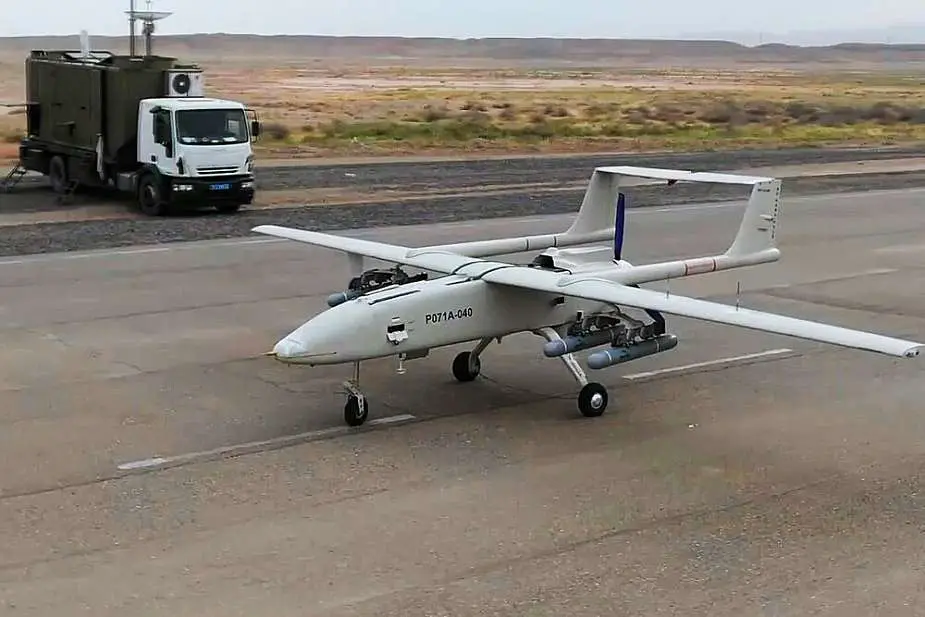Breaking News British Intel: Russia Deploys Iranian Mohajer-6 Drones in Crimea to Counter Ukraine
On March 8, 2024, the British Army Intelligence Services unveiled critical information indicating Russia's strategic deployment of Iranian Mohajer-6 unmanned aerial vehicles (UAVs) in Crimea. This development is seen as a direct response to intensified attacks by Ukrainian forces on Russian naval assets in the Black Sea region, highlighting a significant escalation in maritime confrontations.
Follow Army Recognition on Google News at this link

An image published by the British Ministry of Defence (MoD) shows an Iranian Mohajer-6 drone deployed in Crimea. (Picture source British Mod)
The Mohajer-6 drones, engineered for Intelligence, Surveillance, Target Acquisition, and Reconnaissance (ISTAR) missions, are also capable of conducting air-to-surface attacks with free-fall guided munitions. Their deployment is aimed at bolstering Russian military efforts by aiding in the identification of threats following recent aggressive actions by Ukrainian forces. These UAVs are strategically utilized to enhance Russian military operations, especially against the southwestern Ukrainian coastline, amidst an increasing series of Ukrainian assaults on Russian naval forces.
The intelligence report sheds light on incidents where Ukraine successfully downed a Mohajer-6 drone over the Black Sea on September 23, 2022, and an instance where Russian forces mistakenly shot down one of their own drones over Crimea on June 6, 2023. Despite these setbacks, the continued use of these advanced UAVs underscores the vital role of unmanned systems in modern warfare, providing a blend of surveillance and offensive capabilities.
The Mohajer-6's operational range is limited to approximately 200 km at an altitude of 10,000 feet (3,048 meters), necessitating line-of-sight control for real-time operation. However, this limitation can be circumvented by handing over control between multiple ground stations, thereby extending its coverage and effectiveness in operational theaters like the Black Sea.
The Mohajer-6 UAV, a hallmark of Iranian unmanned aerial vehicle development, showcases a blend of advanced design and sophisticated technical features tailored for comprehensive surveillance and precise combat roles. Commissioned into service with the IRGC Navy in 2018, it is powered by a single Rotax 912ULS engine, known for its reliability. The drone's design optimizes for a balance between operational range and payload capacity, featuring a wingspan of 10 meters and an overall length of 5.67 meters. It boasts a maximum payload of 40 kg, allowing it to carry a variety of sensors and weapons while maintaining an empty weight of 450 kg and a maximum takeoff weight of 600 kg. Capable of reaching speeds up to 200 km/h, with a minimum operational speed of 100 km, the Mohajer-6 is designed for versatility, enabling it to perform slow, steady surveillance operations as well as rapid response and repositioning.
Equipped with advanced sensors and electronic warfare equipment, the Mohajer-6 can perform day and night operations, thanks to its third-generation visual and infrared surveillance cameras, covering a maximum range of 55.6 km. It also features a laser designator for precise targeting over distances up to 18.5 km. The UAV's armament capabilities are robust, including a variety of guided weapons and rockets such as the Qaem 1 and Qaem 5, the Almas guided weapon, and the Sadid-345 series, capable of engaging targets up to 8 km away. It can also deploy conventional and laser-guided HYDRA 70mm and Fadak 80mm rockets, enhancing its role as a formidable tool for modern aerial warfare, where versatility and precision play critical roles in operational success.
The escalation in the Black Sea, marked by Ukrainian forces' increased offensive operations against the Russian Navy, has led to a recalibrated defensive strategy by Moscow. By employing drones like the Mohajer-6, Russia aims to achieve superior situational awareness to identify and neutralize threats effectively. This strategic employment of unmanned technology not only highlights the shifting paradigms in military engagement strategies but also underscores the intricate web of international alliances affecting the region's stability.
As the conflict continues to evolve, the strategic importance of the Black Sea as a theater of military operations becomes ever more apparent. With both Ukrainian and Russian forces preparing for further escalations, the deployment of sophisticated technologies and the involvement of international partnerships reveal complex dynamics at play, with significant implications for regional and international security. The use of sophisticated unmanned systems like the Mohajer-6 UAV in such conflicts underscores the continuous evolution of warfare strategies and the critical role of technological advancements in shaping contemporary military operations.

Iranian-made Mohajer-6 Unmanned Aerial Vehicle can be used to conduct reconnaissance and attack missions. (Picture source Social Network)
Defense News March 2024
- Hits: 3903
















